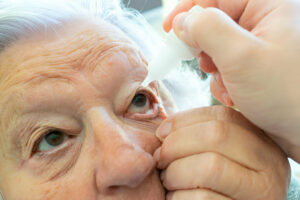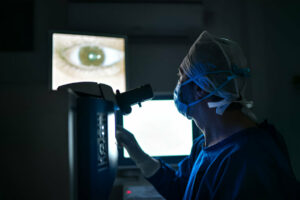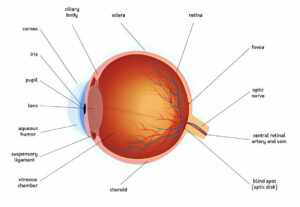
Many eye diseases can result in vision loss. Some, such as glaucoma, do not give any early warning and is one of the leading causes of blindness.
Other eye conditions, like dry eyes, can often be treated effectively using drops and other therapies. This section offers basic information about the eyes and visual system; an alphabetical listing of eye and visual disorders; conventional and alternative treatments; effective nutritional, herbal and homeopathic solutions.
Diabetic Retinopathy
Diabetic Retinopathy occurs when high levels of blood sugar damage the retina, the inner lining at the back of the eye that senses light. Over time, damaged blood vessels can leak fluid onto or grow across the surface of retina causing vision loss; it is the leading cause of blindness among people under 75 and can only be managed effectively with regular comprehensive dilated eye exams and care management practices. This disease may be reduced with proper management practices as well as comprehensive eye exams dilating diopter.
Non-proliferative diabetic retinopathy (NPDR) is the initial stage of diabetic retinopathy, whereby blood vessel walls constrict, leading to fluid, fats and proteins leaking out through abnormal vessels into the retina and swelling it up with fluid, fats and proteins leaking from them. While vision will likely remain intact because blood continues to reach the macula; however if blood vessels close completely then vision may be significantly impaired; symptoms include blurry or shadowy vision or colors appearing faded or washed out colors among others.
At an advanced stage of diabetic retinopathy, retinal blood vessels may bleed into and obstruct the clear fluid inside your eye (vitreous humor), creating bleeding spots that disrupt light transmission and distort your vision. Scar tissue formation could result in detaching retina, leading to blind spots. Furthermore, symptoms in this stage could become more severe such as loss of central or peripheral (side) vision loss; and proliferative retinopathy where new blood vessels grow which bleed or scar causing more severe vision loss than in earlier stages.
Treatment options depend on the severity of your retinopathy. Your doctor can use laser surgery to seal off leaking blood vessels and discourage new ones from forming; sometimes medications will be given to reduce inflammation or inhibit new blood vessel formation; in rare instances vitrectomy surgery may be required to remove fluid from within the eye and decrease swelling.
As part of your ongoing diabetes management efforts, eating well and engaging in physical exercise are also crucial in order to avoid diabetic retinopathy. For best results, get your eyes checked regularly at least annually or more often if symptoms arise. In addition to keeping up with this regiment, regular comprehensive dilated eye exams are highly recommended to detect diabetic retinopathy early.
Glaucoma
Glaucoma is one of the leading causes of blindness worldwide and ranks second in terms of prevalence in the US. It causes damage to the optic nerve due to increased eye pressure caused by either too much fluid production or drainage issues, and once this damage is done it cannot be reversed.
Optic nerves are responsible for transmitting visual information to our brain, enabling us to see. Glaucoma damages the optic nerve, first damaging peripheral (side) vision before progressing to central vision – so it is vital that regular screenings take place, even if you do not experience symptoms.
Glaucoma can be divided into two broad categories of disease: open-angle and closed-angle. Open-angle glaucoma affects eye production of fluid called aqueous humor, but when this production becomes blocked or overflows its expected limits it increases eye pressure causing increased eye pressure – this form is the more prevalent one and often progresses slowly without showing noticeable symptoms.
Closed-angle glaucoma is less commonly diagnosed and occurs when drainage areas in the front portion of the eye become blocked, leading to rapid pressure increase within. It can be extremely painful and lead to symptoms including redness, blurred vision, rainbow halos around lights, severe headaches, nausea and vomiting – which constitute medical emergencies that need immediate medical attention.
Glaucoma can be treated in various ways. Most commonly, medications that reduce eye pressure by helping fluid to drain out or creating new channels for it to escape the eye are administered as eyedrops several times daily; conventional or laser surgery may also be employed as treatments for this condition.
People at risk of glaucoma should schedule regular eye examinations, especially after age 60 and those who have a family history of it. According to the National Eye Institute’s recommendations, anyone considered high-risk should undergo an eye exam with a dilated pupil once every one to two years.
Macular Degeneration
Macular degeneration is a progressive condition that affects the macula of your retina, responsible for providing clear central vision necessary for activities like recognising faces, driving safely, reading books and performing other tasks requiring straight ahead vision. Macular degeneration occurs when retinal cells begin to degenerate and stop producing accurate images for your brain. A telltale sign of macular degeneration could be blurring or distortion in central vision. Straight objects such as telephone poles and venetian blinds may appear crooked. Other symptoms may include decreased color intensity or the development of a blurry spot that impairs your field of vision. Macular degeneration can develop quickly, so patients should contact their physician as soon as they notice any changes to their vision. There are various treatment options available for macular degeneration including medications, injections and laser treatments.
Age related macular degeneration is one of the leading causes of blindness among people over 65 in Western countries, and affects millions of light-sensing cells within the retina, a thin layer of tissue on the back of each eye which converts visual information into electrical impulses that travel back to the brain for processing.
At first, AMD appears as small yellow deposits under the retina known as drusen that do not affect vision loss. Over time however, these drusen can grow larger and break down light-sensitive cells in the macula causing dry age-related macular degeneration (DAMD). If left untreated DAMD can progress into wet macular degeneration where abnormal blood vessels form beneath retina that leak blood and fluid into macula cells causing further vision loss.
Wet macular degeneration leads to rapid vision loss and can result in severe central visual impairment. It has been linked with cardiovascular diseases like high cholesterol and hypertension as well as diets low in lutein and zeaxanthin.
Sodhi’s research seeks to identify subgroups of patients that could safely reduce or discontinue anti-VEGF injection therapy without incurring further vision loss. Anti-VEGF medication injections may slow or halt leaky blood vessel growth and stave off vision loss; however, such injections are costly, inconvenient, and carry risks like infection or retinal detachment. Therefore, she aims to find safe ways of decreasing or discontinuing their anti-VEGF medication injection therapy while maintaining vision health. Sodhi hopes his research can identify subgroups of patients that can safely reduce or discontinue injection therapy without suffering further vision loss.
Strabismus
Strabismus, or an eye condition in which one eye misaligns with or doesn’t look straight ahead, can affect children and adults alike. Contrary to popular belief, however, treatment should be sought immediately as leaving it untreated will only make things more difficult for your brain and make resolution less likely over time. Strabismus can be further classified by its direction: either crossing (esotropia) or outward turning eyes (exotropia), as well as whether its misalignment occurs at intervals or permanently.
Strabismus can be caused by abnormal muscle function or neurological conditions that alter binocular vision, leading to disruptions. When both eyes are aligned correctly, they send consistent images to our brain which then combine into one three-dimensional picture which gives us depth perception. When one or both eyes become out of alignment, our brain receives two separate pictures which may disregard information from one or both affected eyes leading to reduced visual acuity or double vision.
Strabismus usually develops in children, although it can happen at any age. Premature birth and certain medical conditions, like Down Syndrome or cerebral palsy, have been linked with an increased risk of strabismus. Head trauma, eye injuries and surgery may also damage eye muscles and nerves and result in misalignments of vision that lead to misalignments of eye muscles and nerves resulting in misalignments of vision.
Treatment options depend on the severity of deviation and may include corrective lenses, eye patching or surgical intervention to correct it. If it’s left uncorrected via conservative means, complications such as suppression, amblyopia and contractures could arise as a result.
Glasses can help correct strabismus by decreasing focusing effort required and straightening both eyes, while glasses with multifocal lenses or prisms may be prescribed to compensate for differences in focus, offering even clarity levels throughout. Vision therapy may also be employed in order to retrain both eyes to work together more seamlessly – offering significant improvement without surgery being required.














